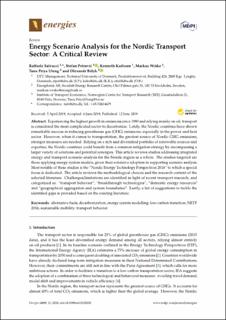| dc.contributor.author | Salvucci, Raffaele | |
| dc.contributor.author | Petrovic, Stefan | |
| dc.contributor.author | Karlsson, Kenneth | |
| dc.contributor.author | Wråke, Markus | |
| dc.contributor.author | Priya Uteng, Tanu | |
| dc.contributor.author | Balyk, Olexandr | |
| dc.coverage.spatial | Europe | en_US |
| dc.date.accessioned | 2021-08-05T10:42:54Z | |
| dc.date.available | 2021-08-05T10:42:54Z | |
| dc.date.created | 2019-07-30T12:35:34Z | |
| dc.date.issued | 2019-06-12 | |
| dc.identifier.citation | Energies. 2019, 12 (12), 1-19. | en_US |
| dc.identifier.issn | 1996-1073 | |
| dc.identifier.uri | https://hdl.handle.net/11250/2766462 | |
| dc.description.abstract | Experiencing the highest growth in emissions since 1990 and relying mainly on oil, transport is considered the most complicated sector to decarbonize. Lately, the Nordic countries have shown remarkable success in reducing greenhouse gas (GHG) emissions, especially in the power and heat sector. However, when it comes to transportation, the greatest source of Nordic GHG emissions, stronger measures are needed. Relying on a rich and diversified portfolio of renewable sources and expertise, the Nordic countries could benefit from a common mitigation strategy by encompassing a larger variety of solutions and potential synergies. This article reviews studies addressing integrated energy and transport scenario analysis for the Nordic region as a whole. The studies targeted are those applying energy system models, given their extensive adoption in supporting scenario analysis. Most notable of these studies is the “Nordic Energy Technology Perspectives 2016” to which a special focus is dedicated. The article reviews the methodological choices and the research content of the selected literature. Challenges/limitations are identified in light of recent transport research, and categorized as: “transport behavior”, “breakthrough technologies”, “domestic energy resources” and “geographical aggregation and system boundaries”. Lastly, a list of suggestions to tackle the identified gaps is provided based on the existing literature. | en_US |
| dc.language.iso | eng | en_US |
| dc.publisher | MDPI | en_US |
| dc.rights | Navngivelse 4.0 Internasjonal | * |
| dc.rights.uri | http://creativecommons.org/licenses/by/4.0/deed.no | * |
| dc.title | Energy scenario analysis for the Nordic transport sector: A critical review | en_US |
| dc.type | Peer reviewed | en_US |
| dc.type | Journal article | en_US |
| dc.rights.holder | © 2019 by the authors. Licensee MDPI, Basel, Switzerland. | en_US |
| dc.description.version | publishedVersion | en_US |
| cristin.unitcode | 7482,1,2,0 | |
| cristin.unitname | Byutvikling og bytransport | |
| cristin.ispublished | true | |
| cristin.fulltext | original | |
| cristin.qualitycode | 1 | |
| dc.identifier.doi | 10.3390/en12122232 | |
| dc.identifier.cristin | 1713194 | |
| dc.source.journal | Energies | en_US |
| dc.source.volume | 12 | en_US |
| dc.source.issue | 12 | en_US |
| dc.source.pagenumber | 1-19 | en_US |

